- Sigma Lenses – Illuminating the Art of Photography
- Top Sigma Lenses For Nikon DSLR Cameras
- Sigma 14-24mm F2.8 DG HSM Art Ultra Wide Angle Zoom Lens
- Customer Reviews Summary
- Sigma 18-35 F/1.8 Art DC HSM Wide Angle Zoom Lens
- Specifications For The Lens
- Summing Up The Sigma 18-35 F/1.8 Art DC HSM Wide Angle Zoom Lens
- Sigma 24-70mm F2.8 DG OS HSM Art Wide Angle Zoom Lens
- Summarizing The Sigma 24-70mm F2.8 DG OS HSM Art Wide Angle Zoom Lens
- Sigma 50mm F1.4 DG HSM Art Prime Lens
- Summarizing The Sigma 50mm F1.4 DG HSM Art Prime Lens
- Sigma 150-600mm F5-6.3 DG OS HSM Contemporary Zoom Lens for Nikon
- Summing Up The Sigma 150-600mm F5-6.3 DG OS HSM Contemporary Zoom Lens for Nikon
- Summarizing The Best Sigma Lenses For A Nikon Mount
- Frequently Asked Questions
Sigma Lenses – Illuminating the Art of Photography
Sigma, a renowned lens manufacturer, has earned its stripes in the photography world for decades. Their innovative designs and optical excellence make Sigma lenses popular. When you decide to buy a third party lens for your Nikon dslr camera, it’s important to do your homework. The lens you pick impacts the quality and style of your photography. Sigma offers lenses from wide-angle to telephoto and everything in between.
In this article, I’ll review the top 5 Sigma lenses for Nikon dslr cameras. And explore why selecting the right lens for your Nikon DSLR is crucial. I will review different types of lenses and their applications, providing insights on which lens might best suit your photography style. Stay tuned for expert tips and recommendations to help you make the perfect lens choice for your camera.
Why Choose A Sigma Lens For Your Nikon DSLR Camera
When it comes to choosing lenses, Sigma offers compelling reasons. Their lenses boast exceptional quality and impressive features. Sigma has managed to carve a niche in the market with lenses that often rival and sometimes even surpass, those from industry giants like Nikon, Sony and Canon.
Celebrated for their optical excellence, Sigma lenses deliver sharp and vivid images. They often come with unique features, such as versatile zoom ranges, advanced coatings and customizable settings. Sigma’s commitment to innovation shines through in their lens designs.
Comparing Sigma lenses to Nikon counterparts, you’ll find Sigma often provides a more budget-friendly option without compromising on performance. Sigma’s art, sport and contemporary lens lines cater to a wide range of photographers, offering diverse choices for various shooting scenarios.
While Nikon, Sony and Canon have established themselves as leaders, Sigma has emerged as a formidable competitor. Photographers looking for high-quality lenses with innovative features at a more affordable price point should certainly consider Sigma as a viable option. In the end, the choice between these brands often boils down to individual preferences and specific photographic needs.
The Basics Of Camera Lenses
Understanding lenses is key. Focal length affects framing, shorter for wide shots, longer for close-ups. The aperture regulates both the amount of light and the depth of field in your photos. Image stabilization reduces blur from shaky hands.
Prime lenses have fixed focal lengths, sharp and bright but less versatile. Zoom lenses offer a range of focal lengths, flexibility in composition.
Your lens choice shapes your photos. Capture the grandeur of landscapes with wide-angle lenses. Telephoto lenses bring distant subjects closer. Macro lenses excel in close-ups. Portrait lenses create beautiful bokeh.
Aperture affects background blur. Wide apertures like f/1.4 produce creamy bokeh. Smaller apertures like f/16 maintain sharpness throughout.
Image stabilization is crucial for handheld shots at slow shutter speeds. It compensates for minor shakes, resulting in sharper images.
Consider lens compatibility with your camera brand. Nikon, Sony and Canon have extensive lens lineups. Other manufacturers like Sigma, Tamron and Tokina offer excellent options.
Your lens choice impacts your style. Experiment and learn, and you’ll discover the perfect lens for your creative vision.
Lens Mount Compatibility For Your Camera
Lens mounts are crucial for attaching lenses to cameras. Nikon DSLRs have distinct mount systems. Nikon uses the F-mount which dictates which lenses are compatible.
The F-mount in Nikon cameras is versatile, but keep in mind older lenses may not autofocus on modern DSLRs.
Understanding your camera’s mount is vital. Check compatibility when buying lenses. Sigma offers lenses compatible with Nikon, Sony and Canon DSLRs, providing photographers with more options.
Top Sigma Lenses For Nikon DSLR Cameras
Below are the best choices for your Nikon DSLR Camera based on hours of researching and summarizing the best features. I’ve summarized most of my research data to make it easier for you to read while providing the most important features required for your decision. If you think I should provide more details then let me know in the comments.
Sigma 14-24mm F2.8 DG HSM Art Ultra Wide Angle Zoom Lens
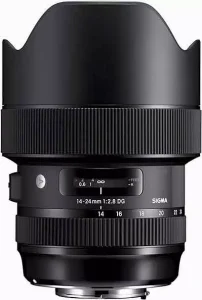
For those using Nikon, the Sigma 14-24mm F2.8 Art is a real gem – ruggedly built and crystal clear. Here’s my summary overview of its most important features and capabilities based on my own research:
Build Quality And Handling
Material and Construction: The lens features a mix of plastic and metallic parts along with Thermally Stable Composite (TSC), contributing to its robustness. A brass bayonet mount enhances durability.
Internal Focusing: The lens focuses internally, maintaining its size during use, and supports full-time manual focus override for increased control.
Focus Ring: It has a large focus ring with hard stops at both ends of the range, aiding precise manual focusing. The lens also includes a clear distance scale.
Weather-Sealing: There is special weather-sealing throughout the construction, including a rubber grommet at the lens mount, making it suitable for use in various environmental conditions.
Optical Performance
Distortion Control: The lens exhibits minimal distortion, a significant achievement for an ultra-wide-angle lens. Any distortion observed is likely due to the angle at which the lens is used rather than a flaw in the lens itself.
Image Quality: It delivers consistent sharpness, color rendition, and contrast across various lighting conditions. The lens performs exceptionally well in low light or dark conditions.
Aperture: The f/2.8 maximum aperture is available across the entire zoom range, beneficial for low-light photography, night sky shooting, and achieving a shallow depth of field.
Creative And Practical Uses
Wide Angle of View: The lens offers a broad angle of view, making it suitable for a range of applications like real estate, travel, group photography, and environmental portraiture.
Versatility: Its combination of a wide 14mm focal length, fast f/2.8 aperture, and close focusing distance opens up numerous creative possibilities.
Lens Specifications
Customer Reviews Summary
Customers often praise the lens for its solid build quality and smooth operation. The Hyper Sonic Motor (HSM) autofocus is highlighted for its quick and quiet performance.
The lens is commended for taking great shots at low light in various settings. The combination of the wide lens, fast aperture, as well as the ability to focus pretty close up makes it super useful for everything from everyday pics to artistic shots.
Read through the pros and cons below for some of the most discussed customer reviews based on my research.
In summary, the Sigma 14-24mm F2.8 DG HSM Art lens is celebrated for its outstanding build quality, excellent optical performance, and creative versatility, making it a valuable addition to a photographer’s kit, especially for those interested in wide-angle photography.
Pros
Cons
Sigma 18-35 F/1.8 Art DC HSM Wide Angle Zoom Lens
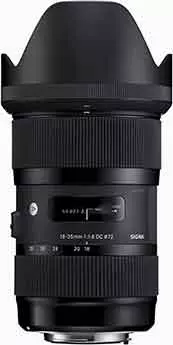
It’s known for letting in loads of light and taking super sharp pictures, so it’s fantastic for outdoor scenes, people shots, and dim settings. I’ve included the most important details below.
The Build And Handling Of The Sigma 18-35mm Lens
Quality of Materials: Its constructed from premium material, which means it’s built to last and take a beating.
Weight: Its fast speed, metal construction and 17 lens elements contribute to the 810 gram weight.
AF Performance: The Hyper Sonic Motor (HSM) provides fast and quiet autofocus performance, which is crucial for both still photography and videography, particularly in situations where noise can be disruptive.
Ergonomics: The zoom ring is smooth with nice resistance, and the focus ring is very smooth. A switch toggles between autofocus and manual focus. The middle and front parts of the barrel, including the filter thread, are made of plastic to reduce weight.
Lens Hood: It comes with a plastic hood which mounts in the regular or opposite direction for storage.
Optical Performance
Aperture: The f/1.8 aperture allows for a shallow depth of field, which is useful in various photography styles, including landscape and indoor events. However, at wider angles like 18mm, the background may not appear as blurred as expected.
Distortion: There’s moderate barrel distortion at the wider end and pincushion distortion at the longer end. Post processing in Photoshop or Lightroom corrects these distortions.
Focus Breathing: The lens exhibits slight focus breathing, which may be of interest to cinematographers.
Ghosting and Flare: The lens has less efficient coatings compared to professional-grade brands, which affects its resistance to ghosting and flare.
Specific Features
Use on Full-Frame Cameras: I don’t recommend using this lens on full-frame cameras at shorter focal lengths due to significant vignetting.
Portraits: I suggest shooting half-body or group portraits due to the perspective distortion at closer distances.
Specifications For The Lens
Summing Up The Sigma 18-35 F/1.8 Art DC HSM Wide Angle Zoom Lens
Overall, the Sigma 18-35mm f/1.8 Art HSM is a high-quality lens with a unique combination of a wide aperture and zoom range, suited for many types of photography. It doesn’t mean it is a perfect lens because it comes with some disadvantages regarding ergonomics and genre construction for some kinds of photography.
What makes this lens surprisingly stand out is it is first in its class to offer such a wide aperture across its entire zoom range. Which makes it a standout and highly sought after edition.
Despite its weight and size, factors that have been criticized in consumer reviews, both the lens’s build quality, optical performance and the versatility provided by f/1.8 are features that reviewers seem to have praised. As always I want you to think about your needs and only use the reviews as guidelines to help you make a decision. The beauty about photography and photographers in general is everyone has different styles and needs.
I have found through my many years of shooting images that most optical issues are fixable using Lightroom, Photoshop or a similar photo editor for post processing.
Pros
Cons
Sigma 24-70mm F2.8 DG OS HSM Art Wide Angle Zoom Lens
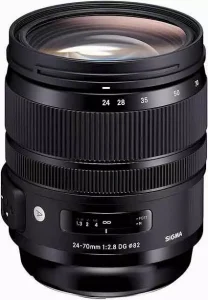
The Sigma Lens 24-70mm F2.8 DG OS HSM Art is a lens for the Nikon system, and fits many of the latest camera bodies with Nikon’s F-mount system. Sigma has developed quite a reputation for this particular line-up, and the Art range goes some way to contributing to that.
Build and Design
Construction: The build quality is good, appropriate use of metal and thermally stable composite material for durability and resistance against thermal expansion and contraction. It accommodates a rubber gasket that lines the mount for dust and splash proofing.
Ergonomics: Fine-textured rubber makes sure that operation is good to the focus rings and zoom. The lens hood snapped on with a rubberized ring secure it perfectly and feel premium.
Weight and Size: It weighs slightly more than some of its competitors though it is lighter by a little in comparison to Nikon’s equivalent. The weight issue is noticeable but manageable on cameras that have a larger handgrip.
Optical Performance
Focal Length Range: On full-frame camera’s it provides a versatile range wide angle to short telephoto, ideal for general photography On the APS-C cameras, it gives a 36-105mm equivalent angle of view.
Aperture: The simultaneous f/2.8 aperture through the zoom range allows one to usually shoot in low light situations as well as gives an opportunity of controlling the depth of field. It is one of the brightest options available in its class.
Image Stabilization: This is an important feature to provide quality picture results in less light conditions hence assist in controlling camera shake especially at a longer focal length.
Image Quality: The lens dishes out sharp images, particularly when stopped down from f/2.8 to f/4. Centre sharpness is excellent right across the range with a gentle improvement in corner sharpness at the narrower apertures.
Chromatic Aberration and Distortion: Chromatic aberration is rather under tight control at the center, with slight fringing present at the edges, most obviously seen with 70mm. Distortion is observable at both 50mm and 70mm, but this is correctable using distortion control settings in-camera as well as software.
Bokeh Quality: The 9-bladed diaphragm contributes to the creation of smooth and pleasing bokeh, which comes in very handy in portraiture when you use longer focal lengths.
Specifications For The Lens
Summarizing The Sigma 24-70mm F2.8 DG OS HSM Art Wide Angle Zoom Lens
The Sigma 24-70mm F2.8 DG OS HSM Art lens stands out with its absolutely robust build quality, stupendous optics and ultimate versatility as a competitive standard zooming lens in this class. It provides a feeble balance between price, features and performance which will make it very hard to overlook for the photographers.
Another thing that makes the lens so appealing would be its consistent f/2.8 aperture, which offers great low-light potential and depth-of-field control—both of which only highlight its versatility in multiple shooting situations especially as far as portraits to landscape style shots go. Finally, OS or Optical Stabilization function proves to be a huge advantage for handheld shooting when conditions are at their worst.
The Hyper Sonic Motor (HSM) ensures fast and silent autofocus, a critical aspect for both still and video applications. With its professional-grade image quality and durability, this lens will become an ideal tool for those photographers who are looking for a reliable all-around lens, as it may fit well for almost any type of shooting – from events and travel to artful creative ones.
Pros
Cons
Sigma 50mm F1.4 DG HSM Art Prime Lens
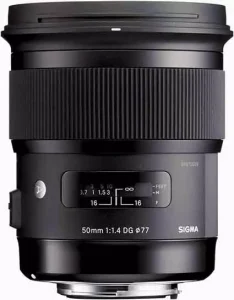
Sigma 50mm F1.4 DG HSM Art lens for Nikon is the high-speed standard prime lens that realizes incredible optical quality and an exceptional build. Here’s some detail about its features, technical specifications and customer reviews.
Build And Design
Sigma 50mm F1.4 DG HSM Art lens for Nikon is a paramount prime lens, known for an excellent build and excellent performance history. It has been developed under strict precision with the use of solid construction employed in high-quality materials. With a bright f/1.4 aperture rating, this lens is perfect for low-light shooting as well as producing beautiful background blur, or bokeh.
The barrel of the lens has an elegant design with rubberized rings that are textured so that the lens could be gripped easily while focusing or regulating settings, for precise control. The build of the lens is made out of high-quality materials, including metallic components, providing strength and durability at all times. Overall construction reflects durability of Sigma commitment to build quality that is user-friendly and makes it reliable choice for photographers valuing both the ergnomics as well the build quality of its equipment.
The best 50mm focal length for portrait photography since it provides excellent subject isolation with a nice creamy background. There is no doubt that this is one Art lens by Sigma that is at the very top among Nikon users who seek to have an uncompromised image quality as well as build excellence – whether you are a pro or an enthusiast.
Optical Performance
The optical design incorporates aspherical and SLD elements designed to lessen aberrations and distortion, providing gorgeous sharpness and clarity. The Hyper Sonic Motor (HSM) guarantees high-speed, along with very quiet autofocusing, great for both photography and videography needs.
Optical Design: An advanced optical design incorporates 13 elements in 8 groups which include three low-dispersion (SLD) elements and an aspherical lens element for high image quality.
Effects of Diminished Sagittal Coma Flare: At wide-open aperture, an ideal large-aperture standard lens will generate excellent image quality across the image plane. Sagittal coma flare is an optical aberration in which near-peripheral point light sources take on a tail-shaped (‘coma’) appearance not round. To reduce this, Sigma incorporates a precision-molded aspheric lens element at the rearmost lens group. Being able to minimize the streaking of point light sources near the frame’s edge, this lens is a very good for taking photos of celestial bodies and the night illumination.
Axial Chromatic Aberration Reduction: Trying to correct axial chromatic aberration with image processing software is challenging at best. This lens adopts SLD (Special Low Dispersion) glass to minimize axial chromatic aberration and keep its correction small. Thus it provides sharp, high-contrast image quality throughout the frame.
Correction of Distortion: Optical aberration or distortion, results in the bending or curving of straight lines. Sigma reduces this aberration during the design phase. Aspheric elements and optimized power distribution reduce distortion across the frame.
Peripheral Illumination: The availability of larger aperture lenses subjects them to less peripheral brightness. With the forward lens group being the large-aperture, efficiency thus increases. The result is increased brightness at the image edges and consistent image quality across the entire photo. Even when shooting wide open, you capture a vivid blue sky without worrying about brightness reduction with the same bokeh effect.
Lens Specifications
Summarizing The Sigma 50mm F1.4 DG HSM Art Prime Lens
The Sigma 50mm F1.4 DG HSM Art lens is a well built, practical and sturdy lens. It has an added feel of improved quality in comparison to that of its competitors as well. The optical design comprises of the addition of SLD and Aspherical elements ensuring extremely high image quality. With a large f/1.4 aperture, it’s perfect both in low-action and low-light conditions while ensuring that the backgrounds are being attractively blurred. The lens uses 77mm filter size and has quite a small minimum focusing distance level, namely about 40cm. Notably, it lacks optical stabilization and weather sealing.
In terms of performance, the lens offers excellent sharpness, especially at f/4, with controlled chromatic aberrations. Vignetting is present at wider apertures but is correctable in post-processing, while distortion is minimal. Bokeh quality is smooth thanks to its 9-blade diaphragm. Customer reviews praise its image quality and build but note its size, weight, and price as potential drawbacks.
Additional features include tactile feedback, ergonomic design, a premium aesthetic, and compatibility with Sigma’s USB Dock for firmware updates. Its optical design minimizes spherical aberration and digital anomalies. The lens is suitable for full-frame and APS-C cameras and boasts professional-grade image quality.
Pros
Cons
Sigma 150-600mm F5-6.3 DG OS HSM Contemporary Zoom Lens for Nikon
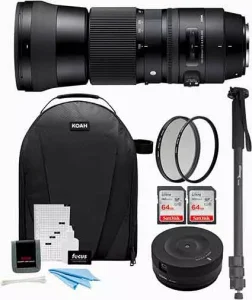
This Sigma 150-600mm F5-6.3 DG OS HSM Contemporary is one of the world’s first all-in-one telephoto zoom lenses for Nikon DSLR cameras. This particular lens can be considered as being in the Contemporary series of Sigma, which mostly comprises of compact and portables products with greater optical quality than all other conventional models in the production line-up.
This makes it ideal for photography targeting specific subjects or scenes at a distance, thus it could easily be used with wildlife, sports and outdoor photography. Coupled with a solid focal length range and an inbuilt optical image stabilization, the lens provides one with an opportunity to capture some good long range photos even under difficult shooting circumstances.
In this review, I will dwell on the lens build quality, its optical performance, creative applications, technical specifications, and provide a summary of its pros and cons that would help you to evaluate if it serves your photography needs.
Build Quality And Handling
It has sturdy build quality. The lens construction is very rugged in that the lens combines a mix of metal and high-quality plastic components. To some extent, the lens barrel is weather-sealed, hence it seals against dust and moisture quite well.
The zoom ring and the focus rings are designed well to offer a good grip. Additionally, in case one may use it on monopod or tripod, the lens includes a tripod collar for rigidity of support. Overall, it offers a good balance between build quality and portability.
Optical Performance Of The Lens
From an optical standpoint, the lens comes with superior performance considering that it goes for a reasonable price in the market. It has a vast focal length range from 150mm to 600mm, meaning that it is good to be used across the different types of photography such as wildlife, sports, and telephoto shots.
It constitutes a special composition of glass elements and coatings allowing it to minimize chromatic aberrations as well as functionalities to boost overall image quality. It offers sharp and detailed images over a large zoom range. Like many telephoto zoom lenses, it performs best when used at lower apertures (e.g., f/8 to f/11).
This lens also comes with optical image stabilization (OS), excellent for use with longer-focal-length lenses. It really proves to be useful in suppressing the effect of camera shake, enabling superior handheld photography compared to its peers even at relatively slower shutter speeds.
Creative And Practical Uses For The Lens
This lens is perfect for more than just wildlife photography; it’s adaptable to various creative needs. It ranks among the favorites that include situations where subjects are far away and during action subjects.
This makes it equally a great sports lens since the use of the fast aperture will help in capturing any subject that’s moving at lightning speed. Apart from that, the lens can still manage astrophotography with some reservations due to the employment of the variable aperture.
Lens Specifications
Summing Up The Sigma 150-600mm F5-6.3 DG OS HSM Contemporary Zoom Lens for Nikon
I believe this lens proves its a very rounded telephoto-zoom option for Nikon DSLR photographers to choose from. It’s built solidly and while not weather-sealed, it copes well with light rain and exhibits superb optical performance considering its modest price point.
First, its versatile focal length range, coupled with optical image stabilization and accurate autofocus make it the ideal outdoor lens for wildlife and sports photography. Although a variable aperture and weight may pose some slight challenges, affordability, sharp image quality, and image stabilization compensate for its minor challenges.
Its only downsides would be the 95mm filter size and slight distortion at extreme ends of the lens. Overall, it is a compelling choice for the telephoto enthusiasts.
Overall most customer reviews were favorable and gave high praise for the lens. One reviewer provided some excellent advice about fine tuning your lens autofocus with your camera using the hub provided in this bundle. This is something everyone should do with all your lenses and cameras. I was able to achieve this through my lenses and cameras and the results were out of this world.
Pros
Cons
Summarizing The Best Sigma Lenses For A Nikon Mount
Sigma lenses are great for photographers that are on a budget yet want great quality. These lenses do extremely well because of their compelling price to performance ratio compared to the big brand names such as Canon, Nikon or Sony.
First, Sigma offers a wide range of lenses, ensuring there’s something for every photographer. Ranging from versatile zooms to specialized primes, Sigma caters to diverse shooting needs.
Second, Sigma lenses are known for sharpness and optical perfection. They use advanced glass elements and coatings to deliver impressive image quality over their most expensive rivals..
Sigma’s commitment to affordability doesn’t sacrifice build quality or durability. Their lenses often feature robust construction, weather sealing and smooth focus rings.
Lastly, Sigma lenses are compatible with multiple camera brands, ensuring accessibility for all photographers.
In essence, Sigma lenses are cost-effective in such a way that they can strike an impressive balance with professional results. Hence making them the best choice for photographers who happen to be on budget.
